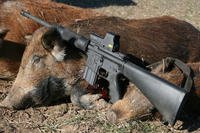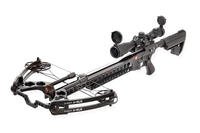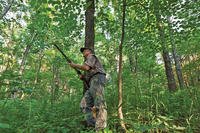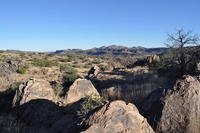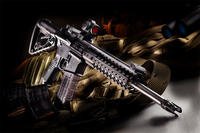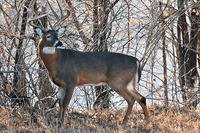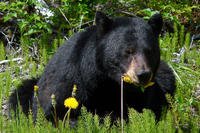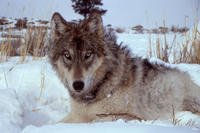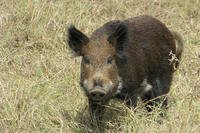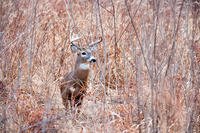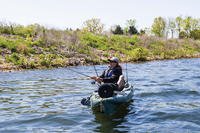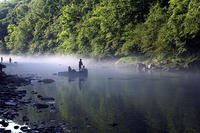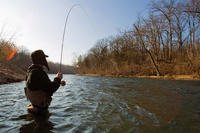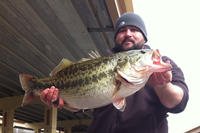It’s a technique that’s been used since the first hunter outsmarted his prey, but the quick-learning coyote needs a new presentation every season.
By Andrew Lewand
Feed them, and they will come. This is the mantra for any hunter who relies on baiting to lure coyote into gun range. However, anyone who has sat waiting and watching for three hours in single-digit temperatures knows that even baiting isn't the silver bullet for killing coyote. The art of effective baiting must go beyond finding a road-kill deer and watching over it. The Eastern coyote—in its supernatural ability to survive—has duped hunters at even the most tempting bait stations. To be consistently successful, hunters must improve their baiting methods to stay ahead of the game.
In this article, we take an in-depth look at cutting-edge baiting techniques and concepts from one of the Northeast's most knowledgeable and successful hunters, Brian Downs. As a resident predator caller from Cape Cod, Mass., Downs saw his success rate climbed when he started baiting for coyote. To sustain his success rate, he had to modify and develop new baiting techniques. It was then that he saw his success rate soar!
The Original Recipe
I first introduced PX readers to the coyote baitsicle—a concoction of scrap meat and frozen water—in my Bait & Pitch article. (See PX August 2008.) Downs created the coyote baitsicle out of a necessity to keep bait at his hunting spot while balancing a busy lifestyle. According to Downs, inconsistency in baiting makes for poor success rates. This is where the baitsicle proves so efficient. Frozen scrap meat the size of a 5-gallon bucket is a hard-to-devour bait. The baitsicle can last for several days or even weeks, depending on coyote activity. The premise is simple: just hunt when you can. That being said, there is an art to preparing the perfect baitsicle.
Using venison scraps from his butcher—any meat scraps will work—Downs fills the bucket a couple inches from the top and adds warm water. Downs advises to use warm water because it lets the blood seep into the water, thus creating flavor for the coyote even if no meat is present in the bite of ice. It is important to freeze the bucket fully before setting it afield. If the hunter sets out baits prior to being completely frozen, they will be soft in the middle and melt prematurely. That defeats the purpose of using a baitsicle.
Removing the frozen bait from the bucket can be tricky. Many hunters get frustrated and actually break their plastic buckets as they try to dislodge the frozen bait. Hunters can avoid this mishap with the following method. While home, fill a separate five gallon bucket 1/8 full of warm water. Place the frozen ice bait bucket in the bucket with the warm water. The warm water will surround the frozen bucket and allow the ice bait to break free from inside of its bucket. After about five minutes, remove the frozen ice bait from its bucket and put a spacer (Downs recommends a hockey puck or a piece of wooden 2x4) in the bottom of the bucket. Put the frozen bait back in the bucket with the spacer on the bottom. Now you can easily transport the bait in the bucket, and the spacer will allow the bait to easily slip free at the bait site.
Utilizing long lasting, stationary bait such as the coyote baitsicle, or even a dead deer, is a great way to bait for coyote. However, to be truly consistent, hunters should apply Downs' advanced techniques for increased baiting success.
Confidence Strips
Often coyote will act extra wary around bait sites. They will not commit to a bait site long enough to effectively hunt it. To allow coyote to feel more comfortable at bait sites, Downs established the use of small pieces of bait to be used in conjunction with the main bait. Downs states that "confidence bait" is by far one of the most important aspects of baiting. "It's not the type of bait, but how it is used," he said. He believes that no matter where you put your bait, a coyote will not be comfortable eating it there. For example, a coyote may carry off baits that a hunter places in dense cover to eat in an open field and visa versa. This is where confidence bait comes into play. Take small pieces of butcher scrap meat and scatter them around main bait. Downs scatters his confidence strips anywhere from 50 to 100 yards from the main bait. It is important to place the confidence strips in cover. This builds confidence in the safety of the bait site. Furthermore, putting confidence bait in and around their travel routes will increase your success. When coyote have confidence in baiting setups, they will arrive sooner and stay longer. Once the coyote have consumed the confidence strips, they will move to the main bait where they now feel more secure to feed.
Drag Bag
When coyote fail to visit bait sites "right away," this may discourage hunters new to baiting. Inspections of the bait site are a letdown when the bait remains untouched. Downs admits that sometimes getting them to find the bait can be a problem. His solution is a drag bag. The secret is to get a mesh or burlap bag and fill it with bait – greasy, wet meat works best. Attach six feet of rope and begin to drag it from your bait outward to used trails, always looping back to the bait. The further you drag, the better your chances that a passing coyote will hit that scent and follow it right to your bait. Coyote live by their nose—especially Eastern coyote—so dragging is an integral part of baiting. Don't skip this step.
Dinner Bell
Remember, proper baiting should make coyote feel confident at the bait site. It should also involve natural occurrences in nature, such as other mammals and birds visiting the site. Whatever nuisance birds you have, embrace them. In the northeast, the common crow is prevalent. If you don't already have these birds on your bait, invite them with some corn. Their raucous squawking and cawing will let the coyote know where to find dinner. Also use them as an early warning system for spotting approaching coyote, as they will most likely see them before you do.
Satellite Baiting
Many portions of the northeast consist of dense cover where coyote live out their entire lives. These coyote may grow old and die without a hunter ever seeing one in an open field. Satellite baiting has been the key to Downs' success when it comes to bagging big, wary coyote. This baiting technique—which hunters should not confuse with confidence strips—is the most difficult setup to make. It also requires constant attention and patience.
For starters, place large bait in a shooting lane or opening. Then place three to five smaller baits in the thick cover. Position the baits out so they go from your right to left and in front of your stand, not behind you. Make sure to use the same trail leading from bait to bait. The use of a drag bag is perfect for this set up. The drag bag will allow you to lay down scent from bait to bait and back out to the main bait again. It may take a few weeks to get the dominant coyote in the main bait, but he will come.
Check the bait every few days. If the satellite baits are gone and the main bait is still intact, repeat the above steps, but put out much smaller satellite baits. It's only a matter of time before he hits the main bait. In order to visualize this baiting setup, imagine a baseball field. Place the main bait at home plate. You can place the satellite baits in dense cover you visualize the locations of first, second and third base. The hunter can set up with home plate in view for a shot opportunity.
Pressure Baiting
Even with Downs' marked success at baiting coyote, he never rests on his laurels, and he constantly strives to develop more efficient baiting techniques. His latest strategy is proof of his desire to become even more proficient at his craft. Pressure baiting started with the notion of shortening time on the stand and increasing success. The idea is to condition coyote to feed at a certain time—the time when you will be hunting. To date, this is Downs' number one method for success.
The key is to start with large bait, perhaps a deer ribcage, a large box of scrap or a baitsicle. Then, allow the coyote to eat this bait. Refrain from hunting them. Once the coyote are hitting the bait, begin to wean them off of it. This means you should put out a little less bait every day. This pressures the coyote to visit the bait site earlier because of competition for food. After a successful harvest, revert back to the large bait and start the process over again. Eastern coyote will come and take over a vacated territory. Be consistent with your baiting times. Downs likes to restock the bait in the afternoons, which is the time he will watch the bait. This is a sure-fire way to achieve success on the bait, because this will condition the coyote to visit the bait site while food is available and before other coyote or meat eaters eat the bait.
Downs tells the story of a recent hunt while using this method. One afternoon, two coyote walked out from a field edge at the same time. It took a minute as they seemed to size each other up. The big male broke first, running as fast as he could to the bait. There he stood—hackles up—showing his dominance on the bait. Downs harvested that coyote on the spot, and he knew then that pressure baiting could bring exciting results.
Magic Distance
The common question among bait hunters is "How far do I sit from the bait?" According to Downs, the magic distance to sit from the bait site depends on the terrain. In the thick cover of the Northeast, hunters may find themselves sitting as close as 20 yards from the bait. When the terrain is more open, it is beneficial to sit farther away from the bait site. Brian reports that his "magic" distance for successful shots is 75 yards.
Regarding the wind, Downs notices that the coyote will use cover over wind direction once the proper bait sites is established. Nonetheless, it's best to watch the bait sites with the wind in your face whenever possible.
According to Downs, one of the most common mistakes hunters make while hunting over bait is shooting too soon. When a coyote comes into bait, they will typically stop prior to arriving at bait and assess the situation. They move their heads up, down, left and right, all while looking in the direction of the bait. This is when inexperienced hunters take their shots. However, hunters should not shoot yet. If the coyote doesn't detect any danger, it will close the distance and provide a closer shot.
Conclusion
Proper baiting requires preparation and effort, but the rewards can outweigh the effort—especially if you weigh your success in the fur shed. Any hunter who wishes to try an alternative to calling for coyote can use the advanced methods used by Brian Downs. (Check your state's game laws first, of course.) Hunters who wish to learn more about Brian Downs' baiting techniques can check out his live predator hunting talkcast and read his blog. You can find it on the main page of www.predatorxtreme.com.
